

Science & Environment - Become a nuclear superpower... in ten steps. It's considered the ultimate weapon.
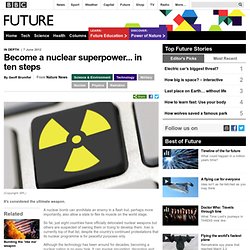
A nuclear bomb can annihilate an enemy in a flash but, perhaps more importantly, also allow a state to flex its muscle on the world stage. So far, just eight countries have officially detonated nuclear weapons but others are suspected of owning them or trying to develop them. Iran is currently top of that list, despite the country’s continued protestations that its nuclear programme is for peaceful purposes only. Although the technology has been around for decades, becoming a nuclear nation is no easy task. It can involve smuggling, deception and years of hard work, not to mention the threat of swift retribution from other world powers. So, what does it take to build a nuclear bomb? Step 1: Choose your isotope Any aspiring nuclear nation will first need to gather its scientists, engineers and technicians. The most common isotopes that can are uranium-235 and plutonium-239. Step 2: Get some uranium Unfortunately, buying in bulk has its drawbacks.
Chernobyl's arch: Sealing off a radioactive sarcophagus. 26 November 2013Last updated at 19:28 ET By Nick Meo Chernobyl Work began in recent days to remove, bit by bit, the giant chimney protruding from the Chernobyl nuclear power station.

It's one small part of a mammoth engineering project, now nearing completion, designed to slash the risk of another major release of radioactivity. Massive and glittering in the weak winter sunshine, a half-built arch looms over Chernobyl's decaying industrial landscape of cooling towers and power lines. One of the biggest engineering projects in history, it has been likened to a gigantic metal igloo, built to seal off hundreds of tons of nuclear fuel and dust buried inside reactor number four, which in 1986 blew up and burned for 10 days. Introduction to Atomic Reactions. The three most common types of radioactive decay which are naturally occurring, are alpha, beta, and gamma radiation.
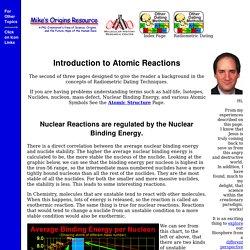
They were found when it was discovered that they responded differently in an electrical field. As can be seen in the graphic, to the left or above, this experiment is very simple. We have a radioactive sample that emits all three types of radiation. The sample is surrounded by a lead block except for a hole that leads to the experiment.
A lead plate with a hole serves as a focuser to let only a small beam through. When the beta rays go through a charged field they bend toward the (+) positive charged plate. Alpha rays bend toward the (-) negative charged plate, so alpha rays are (+) positively charged. In addition to charge, alpha, beta and gamma radiation differ in the degree that they go through matter. A simple sheet of paper, clothing, or even skin will stop alpha rays. Gamma rays have the greatest penetrative abilities. Alpha Radiation Beta Radiation Gamma Radiation. Technological Hazard. Radioaktivitāte. Radiation-interaction.pdf (application/pdf Object) Radioactive Decay.
Radioactive Decay is the decomposition of an unstable atom into multiple parts.
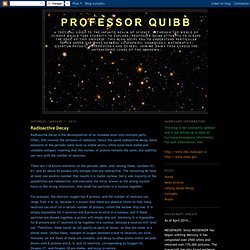
Kā uztaisīt atombumbu? - Bedre.Lv. Apnikusi skola vai darbs?
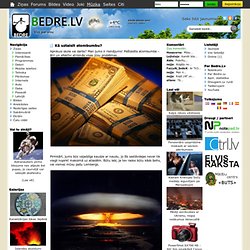
Man jums ir risinājums! Paštaisīta atombumba – ātri un efektīvi atrisinās visas jūsu problēmas... Debating the Meaning of Quantum Mechanics & NOVA's Physics Blog: The Nature of Reality. Why is quantum mechanics like cricket?

Because for me, no matter how many times the rules are explained, I can’t seem to get my head around what the game is actually about. Is quantum theory a system of equations? A description of the behavior of invisible particles? A philosophy for the post-post-modern age? And how strange is it that we even have to ask? This isn’t a question you’d even think to ask about classical mechanics. That’s F=ma. “Quantum mechanics needs an explanation worse than other theories do because others always had a physical picture that guided the formulation of the mathematics,” explains John Cramer, a physicist at the University of Washington who also happens to be the author of his own interpretation of quantum mechanics—more on that later.
“The Copenhagen interpretation is like a religious text,” says MIT physicist Max Tegmark. Yet Heisenberg, like his colleague Niels Bohr, felt that quantum mechanics needed no further interpretation. Radioactive Decay - High School Online Collaborative Writing. Overview Edit.
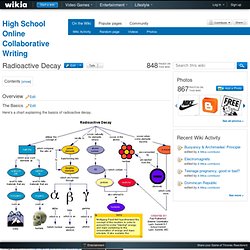
Peter Higgs: honour for physicist who proposed particle. 28 December 2012Last updated at 19:00 ET By Paul Rincon Science editor, BBC News website Here, the Edinburgh-based physicist stands in front of a portrait by artist Ken Currie Physicist Peter Higgs, after whom the Higgs boson particle is named, has been recognised in the New Year Honours.

In the 1960s, Prof Higgs and other physicists proposed a mechanism to explain why the most basic building blocks of the Universe have mass. The mechanism predicts the existence of a Higgs particle, the discovery of which was claimed this year at the Large Hadron Collider. Prof Higgs has been made a Companion of Honour. The recognition confers no title but is restricted to a select group of 65 for achievements in the arts, literature, music, science, politics, industry, or religion.
His discovery announced in July this year of a particle consistent with the Higgs boson immediately led to calls for the 83-year-old to be knighted.